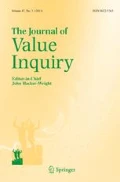References
F. S. C. Northrop, “The Functions and Future of Poetry,” Furioso, I, No. 4 (1941), 71–82; reprinted in Northrop, The Logic of the Sciences and Humanities (New York: Macmillan, 1947), Ch. IX.
“Albert Einstein: Philosopher-Scientist,” in Paul A. Schupp, ed., The Library of Living Philosophers (Evanston, Illinois, 1949), VII, 683–684.
Clyde Kluckhohn, “The Scientific Study of Values and Contemporary Civilization,” Proceedings of the American Philosophical Society, CII, No. 5 (October 1958); reprinted in Zygon: Journal of Religion and Science, I, No. 3 (1966), 230–243.
Northrop, The Meeting of East and West (New York: Macmillan, 1946).
David Prall, Aesthetic Analysis (New York: T. Y. Crowell, 1936).
Thomas K. Swing, The Fragile Leaves of the Sibyl: Dante's Master Plan (Westminster, Md.: Newman Press, 1962).
Stella Kramrisch, The Hindu Temple (Calcutta: University of Calcutta Press, 1946).
Northrop, —op. cit.., note 4.
Albert Einstein, The World As I See It (New York: Covici Friede, 1934), pp. 31–32.
Even Aristotle noted that the sensed objects of sight, hearing, flavor, or shape were relative both to where one stands, when one senses, and hence do not provide objective scientific items of knowledge. He did, however, believe that in the sense of touch of hotness, coldness, wetness and dryness we do naively (i.e., directly) sense the objects.
Northrop, —op. cit.., note 4.
Harvey Rochlein, Notes on Contemporary American Dance (Baltimore, Md.: University Extension Press, 1965), p. 20.
Alfred North Whitehead, Science and the Modern World (New York: Macmillan, 1925), pp. 72 and 74; The Concept of Nature (Cambridge: University Press, 1920), p. 13.
Herbert Read, A Letter to a Young Painter (New York: Horizon Press, 1962).
Brochure of exhibition at the Austrian Institute, New York, March 18–April 8, 1966.
“Tagore: An Asian Poetic and Political Genius” and “The Poetry of God's Playfulness,” in Northrop, Man, Nature, and God (New York: Simon and Schuster, 1962), Ch. 12, esp. pp. 179 ff., and Ch. 18, pp. 246–247.
It can be shown that the same is true for the naive realistic and the epistemically correlated radical empirical-logical realistic segments, and their respective subsegments, of our general theory.
Northrop, ed., Ideological Differences and World Order (New Haven: Yale University Press, 1949), pp. 356–384.
Northrop, Philosophical Anthropology and Practical Politics (New York: Macmillan, 1960).
Northrop and Helen H. Livingston, Cross-Cultural Understanding: Epistemology in Anthropology (New York: Harper & Row, 1964).
Northrop, “Jefferson's Conception of the Role of Science in World History,” Journal of World History, IX, No. 4 (1966) 891–911.
Author information
Authors and Affiliations
Rights and permissions
About this article
Cite this article
Northrop, F.S.C. Toward a general theory of the arts. J Value Inquiry 1, 96–116 (1967). https://doi.org/10.1007/BF00240086
Issue Date:
DOI: https://doi.org/10.1007/BF00240086

